Table of Contents
Liver fibrosis is the scarring of the liver tissue that, with time, can halt the liver’s function. Liver damage can result from infections, metabolic disorders, autoimmune conditions, and various other factors. This results in protein deposits in the liver tissue called collagen and scar formation.
As the liver gets damaged, the cells try to regenerate the dead and damaged cells. So, scar tissue may not form in the initial stages of liver damage.
With repeated damage due to infections and disease, your liver will decompensate. This happens when cell regeneration cannot keep pace with the rate of damage. Or the cell’s capacity to regenerate gets lost over time. Consequently, scar tissue begins to form in the liver cells.
In the Western world, liver fibrosis commonly occurs due to hepatitis B or C infection or chronic alcohol abuse. Non-alcoholic liver diseases (NAFLDs) are also becoming more common due to obesity and diabetes.
Scarred liver cells don’t function normally. Medication and lifestyle changes help repair damage in the early stages. In the later stages, most people require a transplant.
There are various causes and stages of liver scarring. It can be mild with no symptoms or severe liver damage. If scarring continues, it can cause severe fibrosis called cirrhosis (1).
In this article, we will discuss liver fibrosis, its causes and symptoms, the treatment options available, and how to prevent further damage to the liver.
What is liver fibrosis? Causes and symptoms
Liver fibrosis occurs when the liver becomes scarred and cannot function well. Before, it was thought that liver fibrosis was not reversible. However, some fibrosis can be reversed.
The main cause of liver fibrosis is repeated injury to the liver. This can occur due to toxins and infections like hepatitis B and C. When the liver becomes infected for a long period, it responds to the injury by creating scar tissue.
Most types of chronic liver diseases result in fibrosis. Fibrosis in the liver can be either mild, moderate, or severe. You can have fibrosis for 15 to 20 years without symptoms of liver disease. The disease usually progresses to severe liver failure if left untreated.
With advanced fibrosis, most people experience the symptoms of liver damage (1).
What causes fibrosis of the liver?
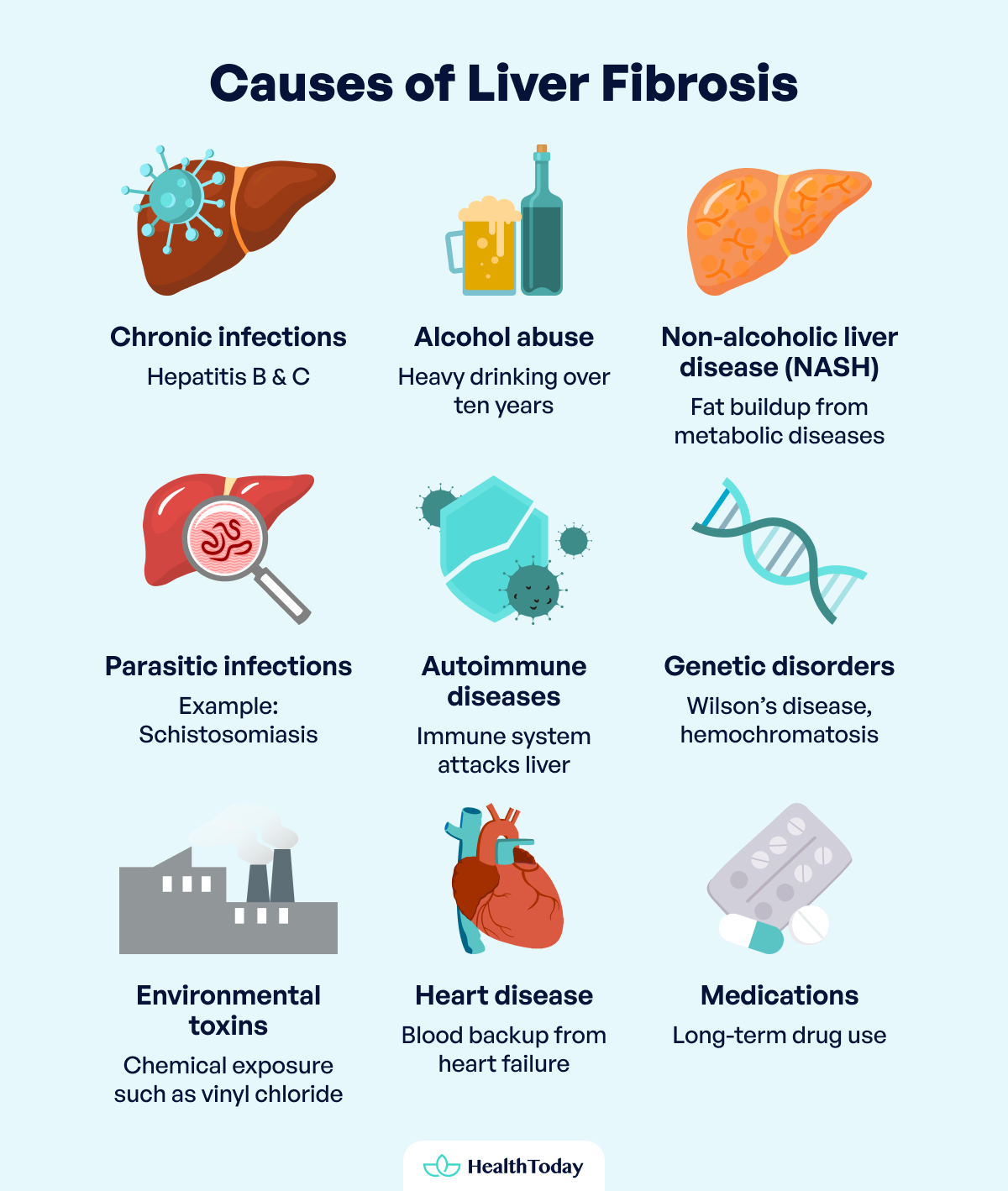
Fibrosis of the liver has several causes. In the United States and Europe, the most common causes of liver scarring include infection with hepatitis C virus and excessive alcohol consumption (2).
Hepatitis B and C are two major viruses that can cause long-term damage. These viruses cause inflammation in the liver cells and buildup of scar tissue.
Alcohol abuse is also a major cause of fibrosis. However, the good news is that the damage, which can develop over ten years of heavy alcohol use, may be reversed by abstaining from alcohol.
Non-alcoholic liver disease, also called non-alcoholic steatohepatitis or simply NASH, is quite common. In NASH, the damage to the liver is the same as the one caused by alcohol. This type of liver disease mostly occurs in individuals with metabolic diseases. In fact, fat gets deposited in the liver, leading to inflammation and scarring.
Some parasites also affect the liver and cause scarring. Schistosomiasis is a liver infection caused by a worm. The parasite worm lays eggs in the liver, which triggers your immune cells to react and lead to fibrosis.
Certain autoimmune liver diseases, in which your own body cells attack the liver, can also cause scarring (5).
Different genetic diseases can also cause liver damage. One such disease is Wilson’s disease, in which copper builds up in abnormal concentrations in the body. Apart from this, Hemochromatosis can occur due to gene problems, which cause excess iron buildup in the liver and lead to liver damage.
Even toxins in the environment can lead to liver scarring. You can be exposed to liver-damaging chemicals in your workplace, such as vinyl chloride used to make plastics.
Chronic congestion of the liver usually causes liver fibrosis in individuals with heart disease. In heart failure, the blood cannot be pumped effectively, so blood starts to back up from the heart into the inferior vena cava, the large vein carrying blood from the lower part of the body to the heart.
Liver fibrosis can also occur due to reactions to some drugs taken over a long period (2).
Liver fibrosis symptoms
When the fibrosis is severe, most people develop liver damage symptoms, which usually worsen with time. Liver fibrosis symptoms include:
- Vomiting blood
- Increased bruising
- Unexplained weight loss
- Itching
- Muscle loss
- Loss of appetite
- Low energy and weakness
- Nausea
On the other hand, some common signs of liver disease include:
- Yellowing of the skin and the white part of the eye (jaundice)
- A buildup of fluid in the belly (ascites)
- Darkening of the urine
- Kidney failure
- Confusion
- Some spider-like veins in the skin (2, 3)
The accumulation of scar tissue in the liver results in higher pressure in the portal veins, which supply blood to the liver. The portal veins carry blood from many body organs into your liver. High pressure can block the flow of blood. This results in a backup of blood in the stomach and the esophagus, the tube connecting the throat to the stomach.
To counter this problem, your body creates new vessels that help bypass the liver. However, the issue is that these vessels are quite thin. When one of the vessels ruptures, there is massive bleeding, which is one of the deadliest complications of liver fibrosis (2).

Liver fibrosis stages and diagnosis
The level of scarring determines the stage of liver fibrosis. Different methods are used worldwide to stage the disease. This helps doctors accurately make treatment plans according to the level of liver damage. Most of the drugs used for treatment are more effective in the early stages when the liver disease is mild.
Your doctor may order a liver biopsy to help stage the fibrosis. A biopsy includes taking out a small sample of the liver tissue with a large needle. The sample is then placed under a microscope to help assess the grade and stage of the liver disease.
A liver biopsy is considered the gold standard for assessing liver damage. However, more cost-effective and less invasive methods are also being used. These include blood tests to measure different types of biomarkers. If these are negative, further testing is usually not performed.
Another method used for determining the stage of fibrosis is liver elastography. In this method, staging includes using ultrasound to measure the stiffness caused by fibrosis in your liver. This test usually takes around 5 to 10 minutes.
Your doctor may use different scales to assess and define the level of liver fibrosis, including the Metavir, Ishak, and Batts-Ludwig scales (4).
Treatment for liver fibrosis
Is liver fibrosis curable? Research shows that scarring caused by infections like hepatitis B and C, alcohol-related damage, and some hereditary liver diseases can be reversed (1).
It usually takes years for the liver to heal fully. In most cases, the goal of the treatment is to prevent further liver damage. The healing time depends on the cause of the liver damage and the extent of the existing scarring (1).
The treatment of liver fibrosis depends on the root cause and stage of the disease. Therefore, doctors usually order multiple tests to find the cause.
Your doctor’s main goal while treating liver fibrosis is to stop it from worsening and prevent complications. The doctor may ask about your medications and exclude those affecting your liver.
These medications may also include some over-the-counter drugs, so it’s important to discuss all medications with your doctor.
If liver scarring occurs due to chronic infection, such as hepatitis B or C, your doctor may prescribe antivirals. In hepatitis B, antivirals are generally prescribed if the virus is actively replicating. In hepatitis C, the antivirals help prevent replication and eliminate the virus from the blood.
The treatment for both hepatitis B and C can last for months until the levels of viral markers are undetected in the blood (2).




Liver fibrosis vs. cirrhosis: What are the differences?
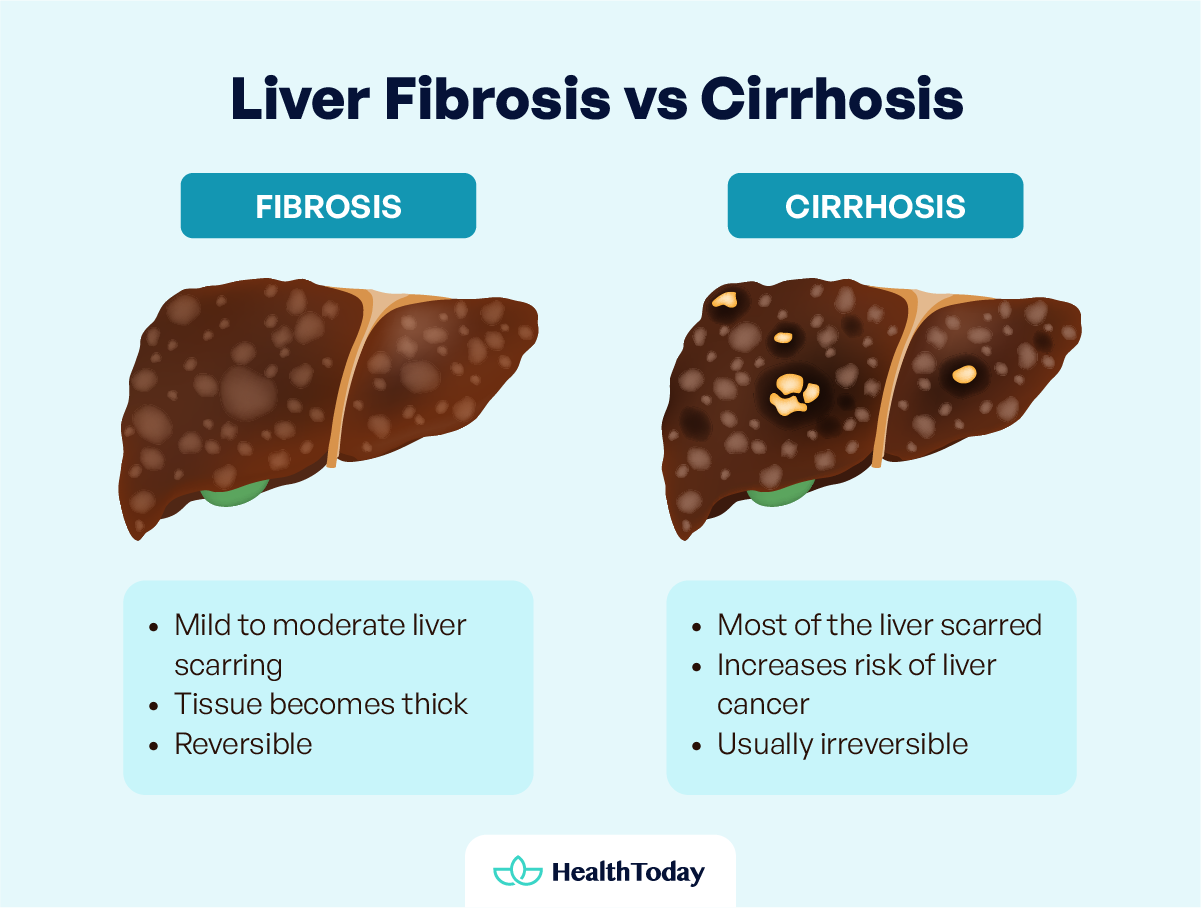

Liver fibrosis refers to any level of liver scarring, which can be mild or moderate. On the other hand, cirrhosis is a severe form of liver fibrosis affecting functions of the liver. Let’s dive deep into liver fibrosis vs cirrhosis.
In fibrosis, the liver tissue becomes thick, making it very difficult for the liver to carry out its basic functions. Proper treatment and care can, in most cases, reverse liver fibrosis.
In cirrhosis, most of the liver gets scarred, and it’s usually not reversible. Besides that, cirrhosis increases the risk of liver cancer (5).
How to prevent liver fibrosis: Practical tips
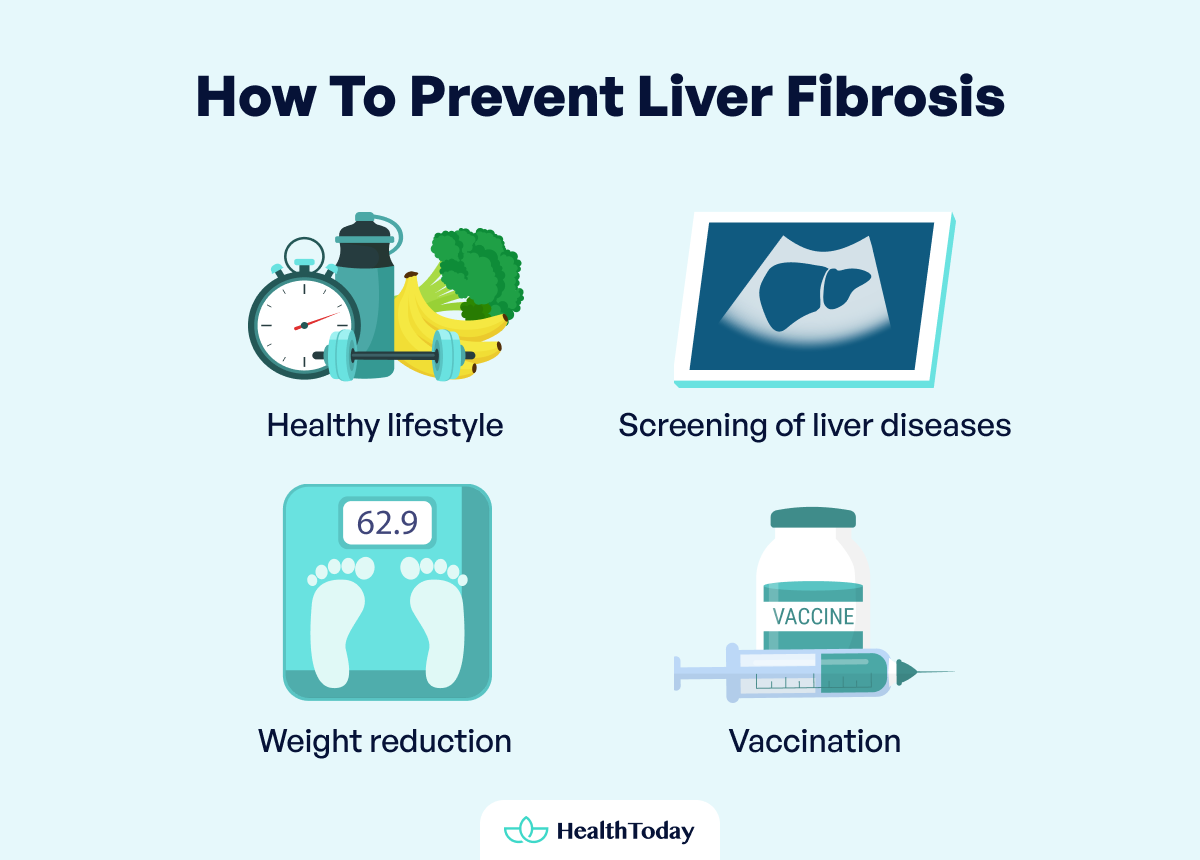

Here are some practical tips to prevent your liver from scarring:
Healthy lifestyle
Regular exercise, a healthy diet, and maintaining a healthy body weight reduce the production of toxic substances in the body. Apart from these, avoiding alcohol can be effective in preventing liver damage.
Screening of liver diseases
Your doctor may order some tests to screen for liver disease. If you belong to the Asian population, your doctor may order a hepatitis B screening every six months, as the infection is more common among Asians (5).
Weight reduction
Liver fibrosis can also occur due to increased body weight and other metabolic conditions. In NAFLD, weight reduction helps. Healthy eating and trying different diets and exercise routines can help reduce weight.
Even without physical activity, weight reduction improves NAFLD biomarkers, including different liver enzymes (6).
Vaccination
Liver disease caused by the hepatitis B virus can be prevented by vaccination. If you live in an area where hepatitis B infection is common, your doctor may vaccinate you, preventing you from becoming infected (7).




What is perisinusoidal fibrosis?
Perisinusoidal fibrosis is a stage of liver fibrosis in which fibrosis occurs around the sinusoids, a type of blood vessel in the liver. Fibrosis in these vessels impairs the liver’s blood supply.
Can you live with liver fibrosis?
A person can live a normal life with liver fibrosis. Complications develop in cirrhosis when the liver gets severely damaged.
How long does fibrosis take to develop?
Liver fibrosis usually takes years to develop. In mild cases, people don’t have any signs or symptoms of liver disease.
Can liver fibrosis be cured?
Mild and moderate liver fibrosis is reversible, but it can take years for the liver to heal from the damage. With advanced liver fibrosis, the chances of the fibrosis healing decrease. In such cases, treatment options focus on preventing further damage.
Does fibrosis mean fatty liver?
Liver fibrosis means scarring of the liver for whatever reason. Fatty liver means fat globules build up in your liver cells (hepatocytes), which can lead to liver fibrosis when prolonged and severe.
You can have a fatty liver without liver fibrosis, but you can also develop liver fibrosis without having a fatty liver. Such cases of liver fibrosis are caused by long-standing viral hepatitis (1).
Summary
This article discusses liver fibrosis, its causes, signs and symptoms, and treatment options. Liver fibrosis is the formation of scar tissue in the liver resulting from various factors. Symptoms can vary greatly, with some individuals showing no symptoms while others experiencing severe manifestations of the disease. Diagnosing the severity of fibrosis typically involves a series of tests ordered by a healthcare provider. The treatment plan will be tailored based on the underlying cause, symptoms, and stage of the condition.






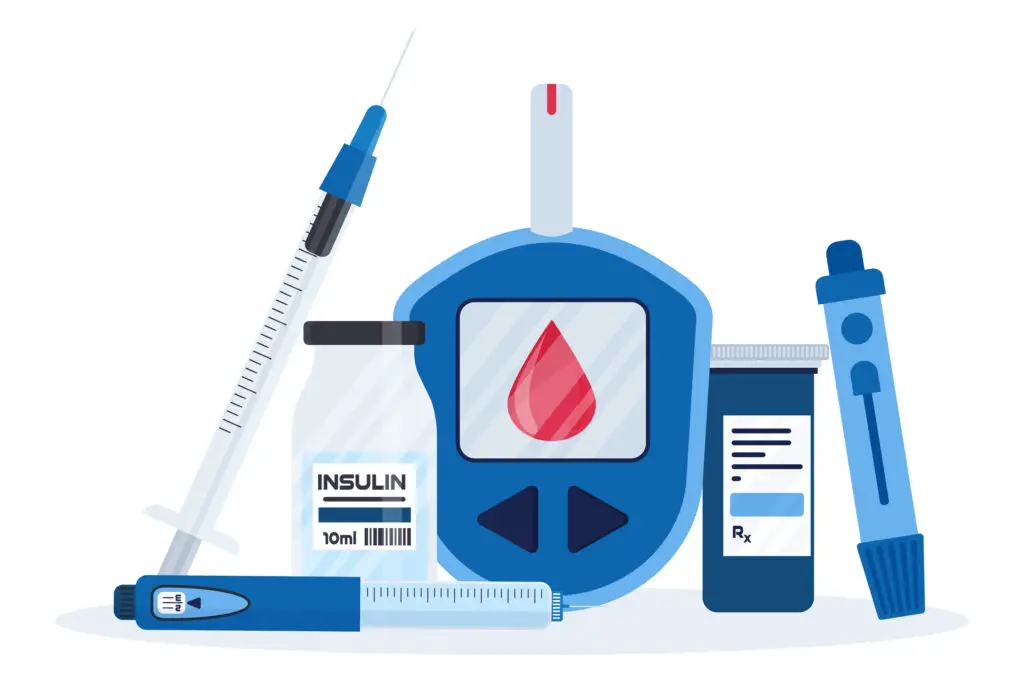



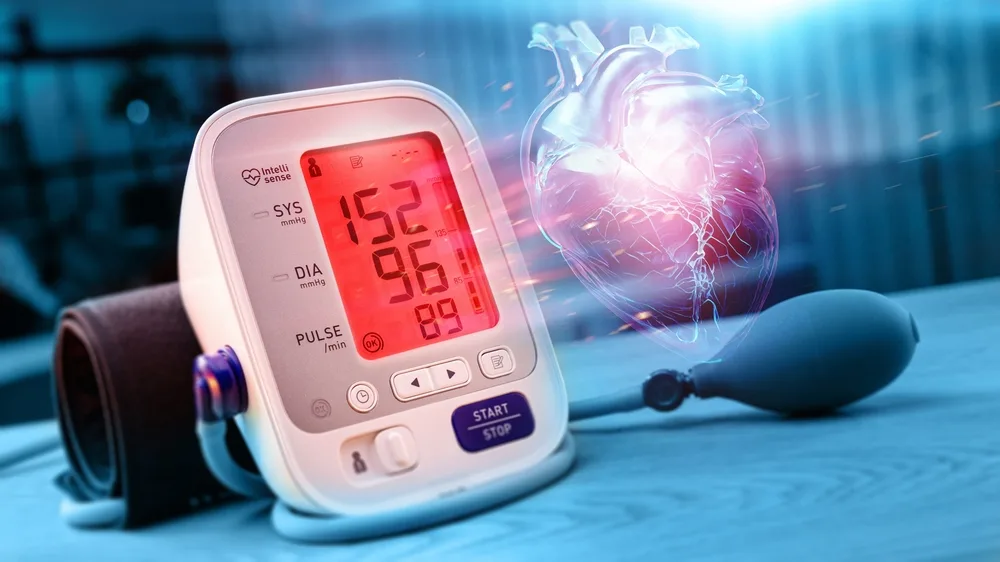






Comments
0